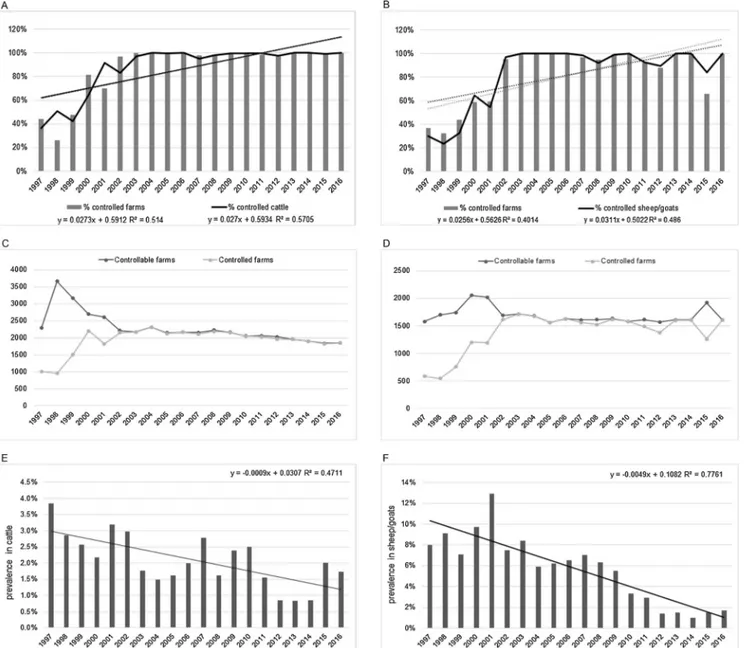ContentslistsavailableatScienceDirect
Journal
of
Infection
and
Public
Health
j o u r n al ho me p ag e :h t t p : / / w w w . e l s e v i e r . c o m / l oc a t e / j i p h
Brucellosis
is
a
public
health
problem
in
southern
Italy:
Burden
and
epidemiological
trend
of
human
and
animal
disease
Alessio
Facciolà
a,
Maria
A.R.
Palamara
b,
Giuseppa
D’Andrea
c,
Fernanda
Marano
c,
Domenico
Magliarditi
d,
Giovanni
Puglisi
c,
Isa
Picerno
b,
Angela
Di
Pietro
b,
Giuseppa
Visalli
b,∗aDepartmentofClinicalandExperimentalMedicine,UniversityofMessina,Italy
bDepartmentofBiomedicalandDentalSciencesandMorphofunctionalImaging,UniversityofMessina,Italy
cEpidemiologyOperativeUnit,DepartmentofPrevention,SanitaryProvincialAgency,Messina,Italy
dVeterinaryEpidemiologyOperativeUnit,VeterinaryPreventionDepartment,SanitaryProvincialAgency,Messina,Italy
a
r
t
i
c
l
e
i
n
f
o
Articlehistory:
Received7May2018
Receivedinrevisedform6July2018
Accepted15July2018 Keywords: Brucellosis Zoonosis Epidemiology PublicHealth
a
b
s
t
r
a
c
t
Background:Brucellosisisthemostcommonglobalbacterialzoonoticdisease.Italianannual2015report onanimalbrucellosiscontrolthatwassubmittedtotheIntegratedNationalPlanoftheItalianHealth MinistryshowedthattheItalianregionwiththehighestprevalenceandincidenceofbrucellosiswas Sicily(3.3%).Thisstudyaimstodemonstratetheburdenofdiseaseandtheepidemiologicaltrendof humanandanimalbrucellosisinMessina,Sicily,from1997to2016.
Methods:Theanalysiswasconductedinthetwenty-years1997–2016.Weexaminedthecomputerised andpaperregistersoftheMessinaProvincialHealthAgencyn.5toevaluatehumanandanimalbrucellosis reports.
Results:1462casesofhumanbrucellosiswerereportedwithanimportantoutbreakin2016inwhich werereported137caseswhiletheprevalenceofinfectedcattleandsheep/goatsdecreasedfrom3.8% and8%,respectively,in1997to1.7%forbothin2016.Astatisticallysignificantcorrelationwasobserved betweenthedecreaseofbothanimalandhumancasesduringtheconsideredperiod.
Conclusions:OurstudydemonstratethatbrucellosisisstillpresentinSicilywithanumberofcases iden-tifiedinbothanimalsandhumansandithypothesisesalargenumberofprobableunderreportedcases. Ourfindingsconfirmtheneedtoimproveknowledgeoftherisksassociatedwithconsumingrawmilk anditsderivatives,mainlyfromsheepandgoats,anddemonstratesthatpublichealthwouldbenefitfrom cooperationbetweenhumanandveterinaryhealthservices.
©2018 TheAuthors.PublishedbyElsevierLimitedonbehalfofKingSaudBinAbdulazizUniversity forHealthSciences.ThisisanopenaccessarticleundertheCCBY-NC-NDlicense(http:// creativecommons.org/licenses/by-nc-nd/4.0/).
Introduction
Zoonosesarediseasestransmissiblefromanimalstohumans throughdirectcontactorthrough food,waterand environment andrepresentanimportantpublichealthproblem[1–3]. Brucel-losisisthemostcommonglobalbacterialzoonoticdisease[4–6]. Ruminantbrucellosisisgenerallytransmittedtohumansthrough theingestionofunpasteurisedmilkderivedfrominfectedanimals (usuallycattle,goatsandsheep),contaminatedundercookedfood orthroughanoccupationalexposure.However,thehigh temper-aturesduringcookingandpasteurisationrapidlykillBrucellaspp.
[7–9].Incountrieswhereitiscommonpracticetopasteurisemilk,
∗ Correspondingauthor.
E-mailaddress:[email protected](G.Visalli).
brucellosishasbecomemoreofoccupationaldisease,especiallyin thoseworkingwithinfectedanimalsortheirtissues(i.e.farmers, livestockbreeders,veterinariansandlaboratoryworkers)[10–12]. However, brucellosisremains an important zoonotic diseasein areaswhereBrucellaspp.isendemicinsheepandgoats,suchas theMediterraneanbasin,SouthwestAsiaandpartsofLatinAmerica
[13].
In2015,27countriesintheEuropeanUnionreportedatotal of437confirmedcasesofhumanbrucellosis,withanotification rateof0.09/100,000individuals.Asinpreviousyears,the coun-triesthatreportedthehighestratesofbrucellosiswereGreece(109 confirmedcaseswithanotificationrateof1/100,000individuals), Italy(105confirmedcaseswithanotificationrateof0.17/100,000 individuals)andPortugal(46confirmedcaseswithanotification rateof0.44/100,000individuals),whichcollectivelyaccountedfor 59.5%stronglyofallconfirmedcasesthatyear.Spainwasfourth,
https://doi.org/10.1016/j.jiph.2018.07.007
1876-0341/©2018TheAuthors.PublishedbyElsevierLimitedonbehalfofKingSaudBinAbdulazizUniversityforHealthSciences.Thisisanopenaccessarticleunderthe
evenwiththewell-knownproblemofunderreporting[16,17]. Italyissuedlawstoeliminatebovine,sheepandgoatbrucellosis, whichhaveledtoasubstantialdeclineofbrucellosisandtothe eradicationofthediseaseinthenorthernItalianregions.In2002, Sicilyissuedthedecree519/2002entitled“Implementationofthe extraordinaryplansforthecontrolofbovine,ovineandcaprine brucellosis”.Moreover,inNovember2006,theMinistryofHealth issuedthe‘Extraordinaryveterinarypolicemeasureson tuberculo-sis,bovineandbuffalobrucellosis,ovo-caprinebrucellosis,bovine leukosisinCalabria,Campania,PugliaandSicily’,whichwas mod-ifiedandupdatedin2012and2015[18–20].However,eradication programmesin thesouthofItaly, especiallyinSicily,were hin-deredbytheincompletecontrolofmovement,theidentification ofanimals,thelackofputtingdownofinfectedanimalsandthe traditionalbreedingpracticesdescribedabove.
In2014,inSicilyandPugliawerepositiveforbrucellosis1519 cattleonatotalof1723animalsculledduringtheyear.Atotalof 13,529sheepandgoatwerepositiveinCalabriaandSicilyin2015 and16,170wereculled[21].
AccordingtotheRegionalVeterinaryEpidemiologicalBulletin (whichispublishedbytheRegionalExperimentalZooprophylactic Institute) in December 2016, of the total official regionally-controlledinfectedcattle/sheepandgoatfarms,76.3%and69.1%, respectively,wereinMessina[22].
Thisdescriptivestudyaimstodemonstratetheepidemiological trendofhumanandanimalbrucellosisinMessina,Sicily,from1997 to2016,showingthepersistenceofthisinfectionandthenecessity ofincreasingtheofficialcontroltoimprovethehealthconditionof breedinganimalsandhumansafety.
Materialandmethods
Datacollection
Theanalysiswasconductedinthetwenty-years1997–2016.In theseyears,thepopulationresidentintheentireMessinaprovince, from1997/12/31 to2016/12/31 decreasedof3.1%rangingfrom 656,646to636,653inthetwoyearsrespectively.37.3%of inhab-itantsliveinMessinatown.Theentireprovincialterritoryisthe ProvincialHealthAgencyn.5(ASP 5)of theSicilian Region.The allAgencyissubdividedin8districts,oneoftheseincludesthe Messinatown.ThecomputerisedandpaperregistersofthePublic Health,EpidemiologyandPreventiveMedicineUnitoftheMessina ASP5 Prevention Department collectallthehumanbrucellosis reports fromall districts.These registers were usedtoidentify humancases,whichweresubsequentlysubdividedbygender,age andthemonthofoccurrence.
Similarly, the computerised and paper registers of the Vet-erinary Epidemiology Unit of the Messina ASP 5 Prevention Department collectallcases of animal brucellosisof theentire provincialterritoryandwereusedtoidentifyallanimalcases.
between1997and2016.Interestingly,thefirst7years(1997–2003) werecharacterisedbymoreintensepeaksthantherestofthe con-sideredperiod,whichcanbeattributedtotheincreasinglevelsof officialcontrolsaftertheemanationofdecree519/2002.Despite thedecreasingnumbersof notifiedcases duringtheconsidered period,theinfectionpersistsinourterritorieswithanumberof casesthat,in2016,resultedinanimportantoutbreaktotalling137 notifiedcases.Theoutbreakthen endedasevidencedbyonly8 expectedcasesreportedbetweenJanuaryandAugust2017(data notshown).Thenumbersofcasesreportedperyearandthe inci-dencesareshowninFig.1A.
During1997–2015,malesaccountedfor60%ofallcasesand females accountedfor40%.The 25–64agegroupwasthemost affected,accountedfor58%ofallcases,andwasfollowedbythe ≥65(15%),15–24(14%)and0–14(13%)agegroups.The hospitali-sationratewas82%andonly6%wasaccountedforbyworkerswho wereatriskofcontractingbrucellosis(i.e.veterinaries,breeders, farmersandbutchers).Concerningthe2016outbreak,therewas nosignificantdifferencebetweenaffectedmalesandfemales.The agegroupspercentagesduringthistimewereverysimilartothose oftheentireperiod.Thehospitalisationratewas46%andonly2% wereat-riskworkers.Themonthlyreportingtrendduringthe2016 outbreakisshowninFig.1B.
Thepeaknumberofreportsoccurredinthefirstpartoftheyear, fromFebruarytoJuly.Thistrendwasconsequenttotheoriginofthe outbreak.Sevendifferentsourcesoftheoutbreakwereidentified, ofwhich40caseswererelatedtothedistributionofalocalcheese (‘tuma’)duringthelivingnativitysceneatChristmas2015ina vil-lageinthesouthernsuburbsofthecity.Therestofthereported caseswereallconcentratedinthesouthernpartofthecityand wererelatedtotheconsumptionoffreshcheesesboughtinshops suppliedbysmalllocalretailers.
Analysingthereportedandthehospitalizedhumancases,we observedaratheroverlapduringtheyearsexceptinthe2016 out-breakinwhichthehospitalizationratewas46%comparedtoan 81%averagehospitalizationrateofallpreviousyears(Fig.2).
Animalcases
Duringtheconsideredperiod,thenumberofcontrolledfarms forcattleandsheep/goatshasincreasedconsiderablyfrom44%and 37%,respectively,in1997to100%forbothin2016.Thenumberof controlledcattleandsheep/goatsalsoincreasedduringthisperiod from36.2%and30.1%,respectively,in1997to100%forbothin2016 (Fig.3A–B).Theincreasewasconsequenttotheimplementationof decree519/2002,whichledtoanoverlapbetweencontrollableand controlledfarms(Fig.3C–D).
Inaddition,theprevalenceofinfectedcattleandsheep/goats decreased from3.85% and 8%,respectively, in 1997to1.7% for bothin2016(Fig.3E–F).Asimilardecreasewasalsoobservedfor thenumberofinfectedanimalsthatwereculledordied(datanot shown).
Fig.1.Epidemiologicaltrendofreportedhumancasesduringthetwentyyears1997–2016(A)andmonthlytrendofreportedcasesduringthe2016outbreak(B).
Fig.2.Comparisonbetweennumberofreportedandhospitalizedhumancases.
Astatisticallysignificantcorrelationwasobservedbetween ani-maland humancasesduringtheconsideredperiod (r0.461for cattleandr0.426forsheep/goats)(Fig.4A–B).Particularly,theslope wassignificantbothforcattleandsheep/goats(P<0.01forboth). Analysingthesteepnessoftheslopeweobservedthata5% reduc-tionofseropostivityincattleandsheep/goatsleadstoadecreaseof 208(95%CI:184.21–288.37)and62(95%CI:56.72–81.51)human casesrespectively.
Discussion
Brucellosisis stillone of themostcommonzoonosesinthe world. Brucella melitensis is known to be the most pathogenic species of the Brucellaceae family, producing the most intense symptoms,thegreatesttissuedamageandthehighestincidence oflocalisationinbodyorgans,systemsortissues[23].However,a separatestudyreportedthattherewasnoevidencethatB. meliten-siswasmorevirulentthanBrucellaabortusorthatinfectionsdueto B.abortuswerelessseverethaninfectionswithB.melitensis,despite thehigherprevalenceofB.melitensisinhumans[24].Bovine bru-cellosisismainlysustainedbyB.abortus,ascattlearethenatural hostandreservoirofthismicroorganism;secondaryhostsinclude bison,buffalo,camelandmoose,whilecasualhostsincludepigs, horsesanddogs.B.melitensisistheprimaryetiologicagentofsheep andgoatbrucellosis.
BrucellosishasbeenacompulsorynotificationdiseaseinItaly since1934andreacheditshighestincidenceinhumansinthelate 1940safterWorldWarII(20casesper100,000inhabitants). Start-ingfromthesecondhalfofthe1950s,followingtheadoptionof
nationalandregionalcontrolplans,adecreaseintheincidenceof thediseaseinhumansandanimalswasobserved[25].Duetothese efforts,themajorityofItalianprovincesarenowclassifiedas “offi-ciallyundamagedterritories”;however,brucellosiscontinuestobe animportantdiseaseinmanyareasoftheMediterraneanregion
[26].
Indeed,brucellosisisstillpresentinSicilywithanumberofcases identifiedinbothanimalsandhumans.Thissituationisstrongly linkedtothepersistenceof alargenumberof infectedanimals inthis territory,especially inthesheepand goatpopulation.In fact, sheepand goatbreeding is themain zootechnical activity oftheregionandisoneofthemostimportantresourcesforthe regionaleconomy.Theproductionoflocalcheeseby smallhold-ersandsmall-scalefarmersisfrequentinthisregion.Inaddition, thepromiscuityofthedifferentanimals(sheep,goatsandcattle) is verycommonand increasesthepossibilityof contamination, transmissionandthespreadofinfections[27].
Theannual2015reportonbrucellosiscontrolthatwas submit-tedtotheIntegratedNationalPlanoftheItalianHealthMinistry showedthat99.6%ofcompaniescoveredbytheprogrammefor theeliminationofbovinebrucellosiswerecheckedandthatthe regionwiththehighestprevalenceandincidencewasSicily(3.3%). Thesamereportalsoshowedthat97.4% ofthecompanies cov-eredbytheeradicationprogrammeofsheepandgoatbrucellosis werecheckedandthattheregionswiththehighestprevalenceand incidencewereSicily(3.7%)andCalabria(1.1%).
Sheep,goats,andtheirproductsappeartobethemajorsources ofinfection,asdemonstratedbytheelevatednumberof brucel-losiscasesintheseanimalscomparedtocattle;theprevalenceof
Fig.3.Comparisonbetweencontrolledfarmsandanimalsforcattle(A)andsheep/goats(B).GraphicsCandDshowtheoverlapbetweencontrolledandcontrollablefarms
forcattleandsheep/goatsrespectively.Prevalenceofcattle(E)andsheep/goats(F)brucellosisintheconsideredperiod.
Fig.4.Correlationbetweenhumanandanimalcasesincattle(A)andsheep/goats(B).
BrucellainfectioninsheepandgoatsinMessinaisthehighestin Italy.Moreover,sheepandgoatsplayakeyroleinthespreadof brucellosisincattleandinhumans;infact,cattlearenottheusual reservoirofBrucellaspp.[23].Theincidenceratesofanimal
bucel-losisarevariableindifferentcountries.InArgentinatheaverage incidencerateis1.7[28],inNigeriarangesfrom9.9to15%incattle
[29],inLibyatheprevalenceofthediseaseis0.2%incattle,8.3%in sheep,and14.8%ingoats[30].
Epidemiologicaldataontheincidenceofhumanbrucellosisare mostlikelyunderestimated,asthediseasehasnonspecificsigns andsymptoms[9,31].
Duringtheperiodconsideredinthisstudy,theaffectedsubjects werecommonlyyoungadultmalesandtherewasnocorrelation betweeninfectionandworkingrisk,asthepercentageofat-risk workerswasverylowduringallperiods,probablybecausethe out-breaksdidnotoriginatefromcontrolledfarmsbutfromunofficial farmingfamilies.Thisfindingisnotinagreementwithother stud-ies[12].Becausethedifferencebetweenthesexesisnotlinked tooccupationalrisks,probablymalesarelesscarefulabout drink-ingunpasteurisedorrawmilkoreatinguncontrolledcheesethan females.
Thisstudyalsoshowedthatofficialcontrolsefficientlyreduced theincidenceofthediseaseinanimalsandhumans,witha sig-nificantdecrement of infected compared to controlledanimals followingtheenactmentofdecree519/2002.Thisfindingwasin linewiththoseseeninotherstudies[32].Thestatistically signifi-cantcorrelationbetweenanimalandhumaninfectionmeansthat veterinarysurveillancecouldeliminatehumanbrucellosis,aswas seeninthenorthernregions[33].
However,theinfectionpersistenceindicatesthatsmall breed-ers, often in the form of farming families who produce and distributehomemadecheese,couldevadetheofficialcontrolsand beamajorcauseofthecurrentsituation.Particularly,thehabitof addingrawmilktofinishedcheesetoimproveitstasteisoneof theprinciplecausesoftheinfection.Infact,whenitwaspossible toidentifythecauseoftheinfection,themajorimplicatedfoods werealwayslocalcheeses(“primosale”,“tuma”and“ricotta”).
Moreover,thedifferenceinthehospitalisationrate between 1997–2015andthe2016outbreakrevealsaprobableand signifi-cantunderreportingrate.Indeed,inlightofthehighhospitalisation rateregisteredinthefirstperiod, itis verylikely thatonlythe hospitalisedcaseswerereportedandnotthosetreatedathome. Probably, themediaattention focusedonthe mostrecent out-breakhaspromptedphysicianstoalsoreportthecasestreatedat home.Probably,alargenumberofnon-hospitalizedcaseswerenot reportedbyfamilyphysicians,thusescapingofficialsurveillance.
Conclusions
Brucellosisremainanimportantpublichealthproblem world-wide. Our findings, although related to a local area, are surely overlappingtotheepidemiologicalsituationofendemic Mediter-ranean countries. The main public health goal is to decrease theprevalenceofbrucellosisamonghumansbyeliminatingthe infectionsources.Preventionshouldincludeimplementingofthe governmental surveillance programme to collect all suspected casesofbrucellosisandfighttheunderreportingwhichisstillmuch probableinthestudiedarea;creatingasmoothandfastflowofdata reportingfromperipherallaboratoriestothespecificnational cen-treandendowingperipheralcentreswiththequalifiedlaboratory personnelandequipment.Moreover,itisalsonecessarytoenforce animalcontrols,vaccinateallsusceptibleanimalsandincreasethe levelofeducationandawarenessamongpeople,especially regard-ingtheconsumptionofnotcontrolledmilkandderivatives.Finally, theconstantprevalenceoftheinfectionin animals,particularly sheepand goats,suggeststheneedtoimprovetheofficial con-trolmeasuresanderadicationefforts,especiallyinbreedsthatare currentlynotcontrolledandinwhich ahighprevalenceof ani-malbrucellosisisoftenpresent.Thisconfirmstheneedtoimprove knowledgeoftherisksassociatedwithconsumingrawmilkandits derivatives,mainlyfromsheepandgoats,anddemonstratesthat publichealthwouldbenefitfromcooperationbetweenhumanand veterinaryhealthservices.
Limitofthestudy
This research focused the attention on a problem that has presentinmanypartsofworldbutthathasbecomeuncommon in high-income countries suchas Northern Europeand United States.Forthisreason,thefindingscouldnotinterestthepublic healthactionsinthelatters.Moreover,wehypothesisean impor-tantunder-notificationrateofthediseasebutwearenotableto demonstrateorquantifyit.
Funding Nofundingsources. Competinginterests Nonedeclared. Ethicalapproval Notrequired. References
[1]DeKnegtLV,PiresSM,HaldT.Attributingfoodbornesalmonellosisinhumans toanimalreservoirsintheEuropeanUnionusingamulti-countrystochastic model.EpidemiolInfect2015;143(6):1175–86.
[2]FacciolàA,RisoR,AvventurosoE,VisalliG,DeliaSA,LaganàP.Campylobacter: frommicrobiologytoprevention.JPrevMedHyg2017;58(2):E79–92.
[3]World HealthOrganization (WHO). Zoonoses; 2018 http://www.who.int/
zoonoses/en/.
[4]NenovaR,TomovaI,SaparevskaR,KantardjievT.Anewoutbreakofbrucellosis inBulgariadetectedinJuly201—preliminaryreport.EuroSurveill2015;20(39).
[5]AloufiAD,MemishZA,AssiriAM,McNabbSJ.Trendsofreportedhumancases ofbrucellosis,KingdomofSaudiArabia,2004–2012.JEpidemiolGlobHealth 2016;6(1):11–8.
[6]LaiS,ZhouH,XiongW,GilbertM,HuangZ,YuJ,etal.Changingepidemiology ofhumanbrucellosis,China,1955–2014.EmergInfectDis2017;23(2):184–94.
[7]PappasG,AkritidisN,BosilkovskiM,TsianosEV.Brucellosis.NEnglJMed 2005;352:2325–36.
[8]PappasG,PapadimitriouP,AkritidisN,ChristouL,TsianosEV.Thenewglobal mapofhumanbrucellosis.LancetInfectDis2006;6:91–9.
[9]FrancoMP,MulderM,GilmanRH,SmitsHL.Humanbrucellosis.LancetInfect Dis2007;7:775–86.
[10]SeleemMN,BoyleSM,SriranganathanN.Brucellosis:are-emergingzoonosis. VetMicrobiol2010;140:392–8.
[11]TraxlerRM,LehmanMW,BossermanEA,GuerraMA,SmithTL.Aliterature reviewoflaboratory-acquiredbrucellosis.JClinMicrobiol2013;51:3055–62.
[12]LytrasT,DanisK,DouniasG.Incidencepatternsandoccupationalrisk fac-torsofhumanbrucellosisinGreece,2004–2015.IntJOccupEnvironMed 2016;7:221–6.
[13]NicolettiP.Relationshipbetweenanimalandhumandisease.In:YoungEJ, Cor-belMJ,editors.Brucellosis:clinicalandlaboratoryaspects.BocaRaton,FL:CRC Press;1989.p.41–51.
[14]EuropeanFoodSafetyAuthority(EFSA).2015:EUsummaryreportonzoonoses,
zoonoticagentsandfood-borneoutbreaks.EFSAJ2016;14(12):4634https://
www.efsa.europa.eu/it/efsajournal/pub/4634.
[15]GrazianiC,ManciniFR,AdoneR,MarianelliC,PasqualiP,RizzoC,etal.La brucellosiinItaliadal1998al2011.Roma:IstitutoSuperiorediSanità;2013 (RapportiISTISAN13/45).
[16]ManciniFR,Bella A,Graziani C,MarianelliC,Mughini-GrasL,PasqualiP, etal.TrendsofhumanbrucellosisinItaly,1998–2010.EpidemiolInfect2014 Jun;142(6):1188–95.
[17]DeMassisF,DiGirolamoA,PetriniA,PizzigalloE,GiovanniniA.Correlation betweenanimalandhumanbrucellosisinItalyduringtheperiod1997–2002. ClinMicrobiolInfect2005;11(August(8)):632–6.
[18]GazzettaUfficialedellaRepubblicaItaliana,SerieGeneralen.285del
07-12-2006—Suppl.Ordinarion.230.Misurestraordinariedipoliziaveterinaria
inmateriaditubercolosi,brucellosibovinaebufalina,brucellosiovi-caprina,
leucosiinCalabria,Campania,PugliaeSicilia.
[19]GazzettaUfficialedellaRepubblicaItaliana,SerieGeneralen.212del
11-09-2012.Misurestraordinariedipoliziaveterinariainmateriaditubercolosi,
brucellosibovinaebufalina,brucellosiovi-caprina,leucosi,nelleregioni
Cal-abria,Campania,PugliaeSicilia(12A09729).
[20]GazzettaUfficialedellaRepubblicaItaliana,SerieGeneralen.144del
24-06-2015.Misurestraordinariedipoliziaveterinariainmateriaditubercolosi,
brucellosibovinaebufalina,brucellosiovi-caprina,leucosibovinaenzootica

